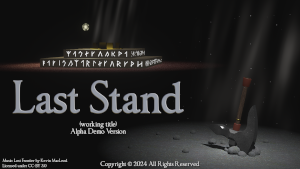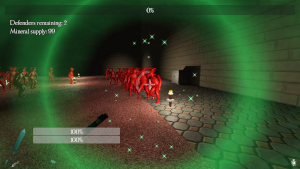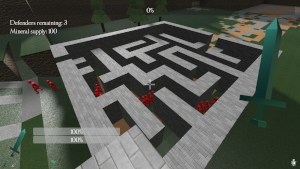Jonathan Nicholl
Software Engineer Portfolio
Last Stand (working title)

Last Stand is a live-service multiplayer game which I developed between jobs using Godot 4. The game was not completed by the time I was forced to pause development, but it is in a playable state.
Gameplay Overview
Gameplay involves a team of 40+ defenders who spend ten minutes gathering supplies and building defenses, after which they are attacked by the monster team, which consists of both other players and NPCs. The defenders are much stronger, but the monsters respawn infinitely. Defenders who die switch to the monster team, and the game ends once all defenders fall or their base is captured. There is no winning or losing.
Communication is done through positional voice chat, or through global or team-separated text chat.
Defenders
Players can select from three defender classes. Players who prefer to play as monsters can also play as serfs, who complete tasks during the prep phase for rewards and leave to become monsters when the fighting starts.

Defender classes so far include the warrior, pyrotechnician, and ranger. Warriors enter a rampage state after slaying a monster, which powers them up to the point of slaying almost anything in one hit. Further kills extend the rampage, but it ends after three seconds without a kill.
Pyrotechnicians have a blaster with area-of-effect damage, allowing them to handle crowds without the need for the rampage. Rangers can attack from afar and deal piercing damage, and have improved mobility. Their scanner tool further allows them to provide support.
Monsters
Players on the monster side earn XP points by killing defenders and destroying their structures. They can spend their XP on undead upgrades, which have three branching paths to select: bruiser, tank, or infiltrator. They can also periodically spawn as special monster types. More, better special monsters become available as the game progresses, so players who join the monsters late aren’t left behind and don’t have to worry about upgrading their undead.
Technical Info

NPC pathfinding efficiently utilizes A* on a separate thread. The A* grid is generated procedurally from the map, then adapts dynamically to the defenders’ structures as they are placed and destroyed. The procedural grid is cached and only needs to be generated once for each game map.
API services implemented in ASP.NET Core provide authentication, inventory management, class selection, a list of ongoing games, and profile information. Ongoing games are stored in a SQLite database, while all other data is stored in a MariaDB database.
The game itself uses Godot’s built-in ENet fork for communication, including for positional voice chat. Authentication is enforced.